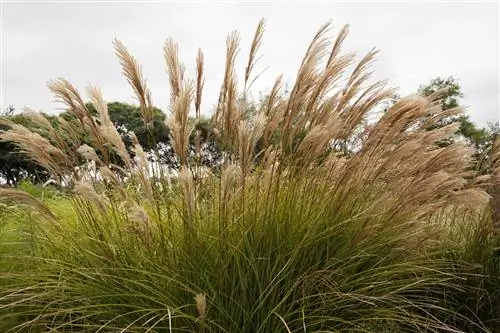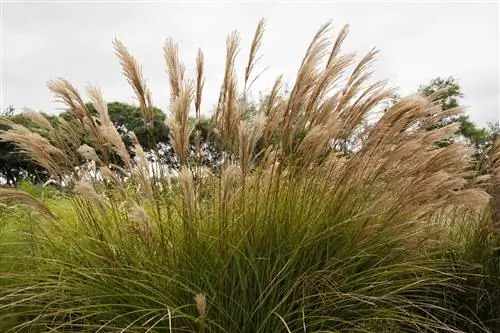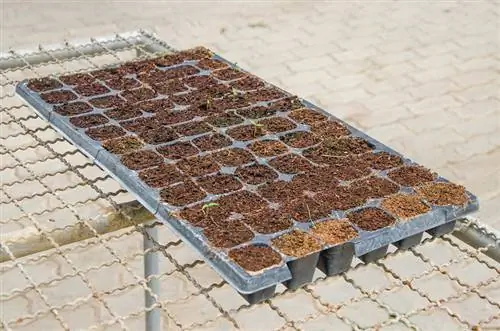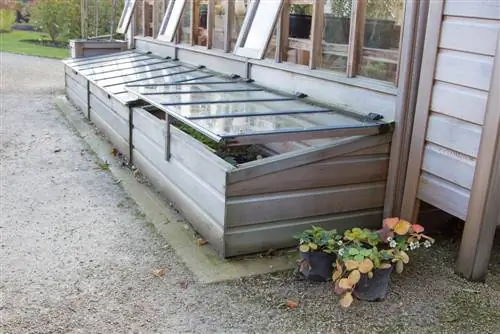- Author admin [email protected].
- Public 2023-12-16 16:46.
- Last modified 2025-01-23 11:22.
Miscanthus, also called Miscanthus or Chinese grass, is an agriculturally valuable plant. Its cultivation is also possible in Germany and is experiencing constant growth. But here we want to dedicate ourselves to cultivation in the home garden, especially when it comes to the impressive decorative value.

How to grow miscanthus in the garden?
Miscanthus can grow permanently in the garden because it is sufficiently hardy. Plant it out in spring in asunny spot in fresh, moist soil. You only need to fertilize and trim Miscanthus once a year at most and only water it during dry periods.
Which location is suitable for growing Miscanthus?
There are different types of miscanthus, all of which have slightly different requirements. That's why you should specifically inquire about it if you're planning to buy. Nevertheless, a common denominator can be found regarding location:
- fresh to moist soil
- plenty of sunshine
- Part shade also possible
- the more sun, the more lush the flowers
- Miscanthus often remains flowerless in the shade
How fast does Miscanthus grow and how much space does it need?
Deciduous varieties grow several centimeters per day if they have optimal living conditions. Evergreen varieties often reach their full height within just one season. Giant miscanthus, usually with the suffix “giganteus”, can grow up to 5 m high. For smaller gardens, varieties with weaker growth are recommended, which can reach a height of between 40 and 150 cm, depending on the variety. These include, among others:
- “Nanus Variegatus”
- “Small fountain”
- “Little Silver Spider”
- “Morning Light”
- “Red Chief”
- Dwarf Miscanthus
So that Miscanthus can fully develop its attractive shape with overhanging leaves, it must not be cramped. The ideal planting distance is between 80 and 180 cm, depending on the size of the variety.
How do I plant Miscanthus correctly?
The best time to plant Miscanthus is in the month of April. Container goods can also be planted until early summer. This is how you proceed with planting:
- Dig up the planting site two spades deep
- Removing stones and weeds
- Work the soil with a rake until it is finely crumbly
- Dig a planting pit (2x root volume)
- if applicable. Establish a root barrier (only for varieties that spread via runners)
- Enrich the excavation with bark humus, leaf compost or horn shavings
- Place the plant in the middle of the planting hole, maintain the previous plant depth
- Fill gaps with soil
- Press the soil firmly
- Set up the pouring edge and pour well
How do I water and fertilize Miscanthus?
Water Chinese grass almost every day after planting; later, small amounts of water are sufficient during dry periods. You should only fertilize poor soils with a complete fertilizer at the beginning of each growing season.
When and how should I prune Miscanthus?
The stalks that dried up in autumn should remain on the plant until spring. Covered with hoarfrost and snow, they are a beautiful decoration. But far more important: they are a natural winter protection. Cut them back to the ground between March and April.
Can I also grow Miscanthus in a container?
Yes, Miscanthus can be grown in a bucket if it is chosen to be very large from the start (at least 30 liters volume) and has drainage holes so that there is no waterlogging. Fertilizing and watering are more often on the care plan. In winter, you must safely overwinter the hardy sweet grass with a cover, as it is more sensitive to frost than planted specimens.
Is Miscanthus susceptible to diseases and pests?
The Miscanthus mealybug can occur very rarely. Variegated cultivars are susceptible to sunburn on dry soils. Miscanthus turns yellow if not cared for properly.
Tip
Miscanthus is easy to propagate
You can quickly build a privacy wall with tall-growing Miscanthus varieties. But this requires several plants. Instead of buying them, you can easily propagate them by dividing them in the spring. Or with a little patience also by sowing.






